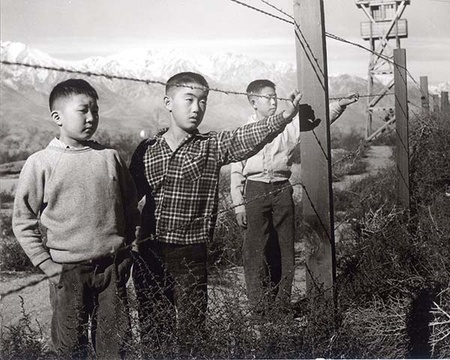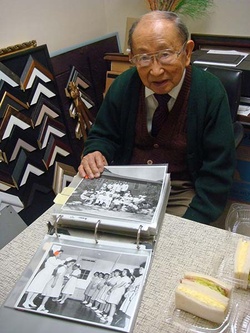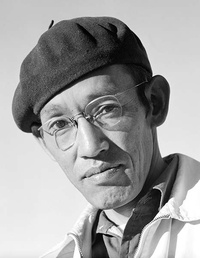Read Part 12 >>
While Lange and Adams photographed Manzanar from the outside, Toyo Miyatake was the ultimate insider. Imprisoned at Manzanar almost from its opening to its closure, from 1942 to 1945, Miyatake witnessed and photographed, at first surreptitiously, then with official permission, a much broader range of scenes and activities than Adams and Lange.
One of the most powerful and well-known of the 1,500 photographs Miyatake took of the concentration camp and its residents depicts three boys appearing to gaze out of the camp through a barbed wire fence, with a guard tower visible in the distance. It was a picture that neither Lange nor Adams could have taken, since the WRA barred the depiction of barbed wire or guard towers in prison photographs. Miyatake had in fact directed the boys to stand outside the barbed wire fence while he shot the picture from inside the prison camp.

One of Miyatake's best-known photographs, of three boys looking through the prison camp's barbed-wire fence, with guard tower in background. Photograph by Toyo Miyatake. (Photo courtesy of Alan Miyatake, Toyo Miyatake Studio.)
By the time Miyatake made this image in 1944, restrictions had relaxed considerably. The government was trying hard to efficiently manage the “leave-clearance” process and the release of all prisoners considered to be loyal. Many prisoners had already left the camp for school or work in inland cities. Another of Miyatake’s photographs, a close-up of a hand holding a wire cutter, about to cut through the barbed wire fence, a guard tower visible in the background, was used in the Manzanar High School yearbook of 1944-45. The text above the full-page photo reads, ‘through these portals…” The facing page featured a full-page photo of a young Nisei couple in business attire, with the man carrying a small suitcase, and bore the words, “….to new horizons.”
This was as overtly political as Miyatake’s Manzanar photographs would get.
He was no crusader for social justice in the Lange mold, attempting to evoke pathos and sympathy for his subjects. He did not photograph the poor living conditions, deprivation, violence, or brutality in the prison camp. His choice of subject matter had little to do with WRA censorship: he simply wasn’t interested in shaping a message of protest, victimhood, or angry rebellion. Instead Miyatake’s photographs ranged from the prosaic (wedding portraits, prison camp baseball games, the Quaker “toy loan center”) to the poetic (scenic nature shots of Manzanar and its environs). When the pain of dislocation appears, it is metaphorical: bleak winter shots, bare trees, cloud formations floating freely above the confines of the concentration camp.

The ireito, or memorial obelisk, in the Manzanar cemetery. Photograph by Toyo Miyatake. (Source: Japanese American National Museum, gift of Yoshiko Hosoi Sakurai. [98.110.4])
Early Days

Archie Miyatake at the Toyo Miyatake Studio, San Gabriel, CA, in 2009. Photograph by Nancy Matsumoto
In early 2009, I visited Miyatake’s son Archie at the Toyo Miyatake Studio in San Gabriel, California, to discuss his father’s and Archie’s experiences at Manzanar. Located on a small, sleepy commercial strip in a residential neighborhood, the studio looked like a throwback to another era, a mom-and-pop business whose retro-looking logo still read TOYO MIYATAKE studio. Although Archie, then 86, was long retired, son Alan still runs the studio, he appeared neatly dressed in a white shirt, tie and vest and was happy to share details about his father’s life and career.
Born in Zentsuji village on the island of Shikoku in 1896, Toyo Miyatake emigrated to the U.S. at 14. His father Junryo had crossed the Pacific earlier, establishing a confectionary store in what was then Los Angeles’s Chinatown before arranging passage for his wife and three sons. Like many young Issei men of the day, Miyatake was captivated by the rapidly evolving field of photography and found his métier within the second-floor studio of the pioneering commercial photographer Harry Shigeta at 2nd Street and San Pedro in Little Tokyo. The young apprentice established a reputation as an avant-garde fine art photographer, emerging as a high-profile figure in the effervescent Little Tokyo cultural and arts scene that flourished in Los Angeles in the 1920s. He won several photographic prizes, including one from the 1926 London International Photography Exhibition.

Toyo Miyatake at Manzanar, 1943. Photograph by Ansel Adams. (Source: Library of Congress Prints and Photographs Division Washington, D.C. 20540 USA)
Miyatake also befriended the well-known dancer and choreographer Michio Ito, who had studied traditional dance in Japan and lived in France and England before emigrating to the United States. Through Ito, Miyatake landed a role as personal photographer to John Barrymore and Thomas Mann. The young artist also became a disciple of Edward Weston, working hard to help his friend and teacher by organizing four exhibitions of his work in the 1920s and ’30s. Weston was impoverished, unknown, and living in Tropico, now part of the city of Glendale. Overjoyed with his first show’s sale of $140 worth of prints, Weston wrote to a friend, “I shall show there every year and let all those who wish to see my work ‘go to Jap. town!’ One poor laundry worker borrowed the money and bought $52.00 worth.” After selling two prints to a Japanese photographer in 1927, Weston confided to his Daybook, “How rarely I sell to Americans! How appreciative, understanding, and courteous the Japanese!” The poor Japanese immigrants of Little Tokyo recognized a kindred sensibility in Weston, who often discussed with Miyatake his keen interest in Japanese woodblock printing and composition.
Photographer Patrick Nagatani, then a graduate student in fine arts at UCLA, worked with Miyatake and co-curators Graham Howe and Scott Rankin to mount “Two Views of Manzanar,” the 1977 UCLA exhibit of Miyatake and Adams’s photographs. When Miyatake pulled out a cardboard box filled with old photographs, Nagatani, in an interview, recalled thinking “Holy mackerel, you guys got original Edward Weston prints just thrown in this box!”
© 2011 Nancy Matsumoto





